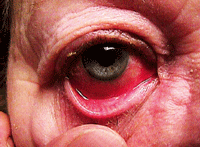 Q: I have a 61-year-old female patient with stubborn blepharitis and an early stye. I was about to prescribe oral doxycycline, but when I asked if she was allergic to antibiotics, she told me she gets yeast infections. How should I handle this?
Q: I have a 61-year-old female patient with stubborn blepharitis and an early stye. I was about to prescribe oral doxycycline, but when I asked if she was allergic to antibiotics, she told me she gets yeast infections. How should I handle this?
A: "Go ahead and give her doxycycline, says Jill Autry, an optometrist and registered pharmacist at the Eye Center of Texas, outside of Houston. Doxycycline is the drug of choice in such cases of eyelid infections that do not respond to lid hygiene and topical medications alone.
But, despite how the patient answered the question, understand that a yeast infection is not an allergic reaction to doxycycline, Dr. Autry says, but rather a common adverse reaction to the drug.
What do you do for a patient with blepharitis who gets yeast infections
when prescribed antibiotics? Low-dose doxycycline is likely the answer.
“Doxycycline can cause thrush in children and yeast infections in women,” she says. “Because it’s a broad-spectrum antibiotic, it’s more likely to dampen the normal bacterial flora in the body. The normal bacterial flora is good for certain things. But if you dampen those flora, then other types of organisms can overgrow, which is what happens in thrush and vaginal yeast infections.”

“When we first started using doxycycline for eyelid problems, we were using the dosage recommended for a typical bacterial infection, which is 100mg twice a day,” Dr. Autry says. “But for blepharitis, we use the drug as much for its anti-inflammatory properties as for its antibiotic properties. So, in the last few years, we’ve been dropping the dosage to 50mg (and even 20mg) when possible, which in many cases is enough to handle the blepharitis. But it’s not enough to really affect the normal bacterial flora, so it won’t likely cause a yeast infection.”
Of course, allergic and adverse reactions do occur from other commonly used oral antibiotics, such as the penicillins and sulfa drugs. For example, if the patient is truly allergic to penicillins, such as dicloxacillin or amoxicillin, try a sulfa drug such as sulfamethoxazole/trimethoprim, available as Septra (King Pharmaceuticals) or Bactrim (Roche).
If the patient is allergic to both penicillins and sulfa drugs, go to a macrolide such as azithromycin, which is available in the popular Zithromax Z-Pak (Pfizer), or an oral fluoroquinolone such as levofloxacin, which is available as Levaquin (Ortho-McNeil-Janssen).
Q: What if I need to prescribe an oral antibiotic in its full dosage, and the patient gets a yeast infection? Do I need to send the patient to her OB/GYN for treatment?
A: Take care of it yourself, Dr. Autry says, provided your scope of practice includes oral antifungals. “A prescription for vaginal yeast infection is one of the easiest things to prescribe. It’s just a single, 150mg dose of Diflucan (fluconazole, Pfizer) in a one-pill blister pack,” she says.
If the patient tells you she gets a yeast infection every time she’s on an antibiotic, you can write the Rx for Diflucan prophylactically, Dr. Autry says. Otherwise, tell the patient to give you a call if a yeast infection develops. (If you don’t have the prescribing rights, you can recommend over-the-counter creams/suppositories to treat a vaginal yeast infection, Dr. Autry says. “Patients prone to yeast infections can also eat lots of yogurt or take acidophilus to avoid getting an infection.”)
Also, you don’t need to contact the patient’s OB/GYN or general practitioner to prescribe fluconazole—unless the patient is pregnant or nursing, because Diflucan, which is Pregnancy Category C, may affect the baby.

